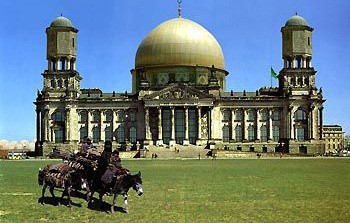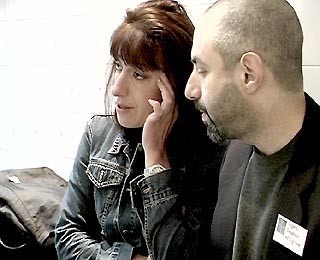
AES (Ryssland), Berlin Reichstag, Islamic Project, 1996 © AES/BUS 1999
AES
AES Travel Agency to the Future – journeys to the year 2006. Stockholm’s city hall with the Islamic half-moon on top. The American Statue of Liberty wearing a veil the Muslim way. The Berlin parliament crowned with a large golden dome. No, the tourist attractions certainly don’t look the way we’re used to at ”AES Travel Agency to the Future”. It’s the Russian artist group AES that has come to town with its ”Islamic project”. The project combines humour, provocation, and humanism, put into an exceptionally gorgeous travel packaging.
The artists Tatyana Arzamasova and Evgeny Svyatsky play the roles of two distinguished travel salesmen behind the small counter in Stockholm’s fashionable Sture shopping mall. The Islamic music winds its way through the premises. It’s 10 am and the customers to the mall come flocking. Ladies on shopping excursions, hurried businessmen, well-dressed teenagers and friends who meet for a cup of a more expensive coffee. Some of them stop at the travel agency ads, others raise an eyebrow and hurry along. The travel agency is a new element in the familiar environment; impeccably well-designed on the outside, but containing something quite different underneath.
A visit to the AES travel agency is an experience of horror-filled delight. In ads for different resorts, well-known Western buildings and monuments have received a considerable touch of Islamic culture, religion, and idiom. On coffee cups, t-shirts, posters and oriental carpets you’ll find this version of the tourist resorts of the future, a version dated to 2006. Consequently, the artists put their finger on a series of phenomena related to the opposition between cultures, countries, and human beings. The two opposing poles which serve as starting points for AES are on the one hand the Islamic fundamentalist dream of world domination, and on the other the Western fear of a ”foreign” culture and religion actually doing it. And behind AES’s computer manipulated images reality speaks for its cruel self in the form of fundamentalist terrorist attacks, and in the form of growing xenophobia in the West.
The ”Islamic Project” also deals with different facets of the globalization of today; Cairo is as accessible as Moscow, New York, or Stockholm, thanks to increases in travel and the quick spread of the new information technology. But these new contact points with the world seem to hold an ambiguous message: ”I’m happy to explore other cultures, as long as they don’t come here”.
The AES members themselves draw a parallel between their project and the psychoanalytic method – both visualise and bring out complexes and phobias in order to examine them. Meeting the Muslims’ half moon in buildings which are the symbols of a Western European country, its culture and democracy, is to stand face to face with one’s own fears and hostility. At the same time, the humorist and absurd dimension is equally important for this project. It’s fun to see minarets that appear unexpectedly in Ragnar Östberg’s city hall architecture. The same effect is produced by the half moon replacing the three well-known crowns on the top. And one has no choice but to laugh at the sight of camels resting on Riddarholmen.
The AES travel agency has visited a number of countries before reaching Sweden: Germany, Austria, USA, France, Poland, and Russia, among others. In every city where the travel agency is established a form is given to the visitors in which they are to fill out details of their reactions to the future that the project presents. The answers have been surprisingly similar from country to country; the explanation AES finds is that every sensible human being equipped with a sense of humour understands what the project is about.
But the travel agency doesn’t make it easy on the visitor who believes that he is free from prejudice and from feeling threatened by another culture. Here no one is safe from his own suspicions of other cultures, religions, or ways of life. AES’s method is to bring out our fears, make us examine them, and then extinguish them with a good laugh.
About AES
AES consists of the artists Tatyana Arzamasova, Lev Evzovitch, and Evgeny Svyatsky. They’ve been working together since 1987 and live in Moscow. Most of the times, though, their work places them ”on an airport in the world”. They often work within the form of a project, but with different strategies and techniques from time to time. Right now they’re writing a movie script.

